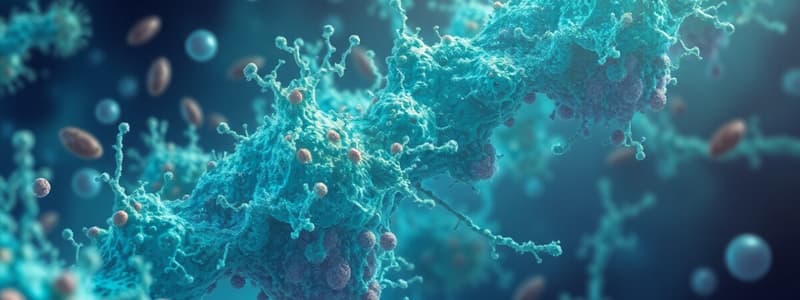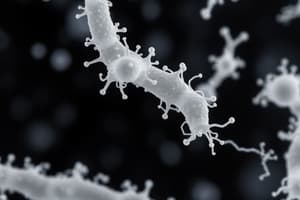Podcast
Questions and Answers
What is the primary purpose of culture methods in microbial identification?
What is the primary purpose of culture methods in microbial identification?
- To isolate microorganisms from environmental samples
- To analyze the genetic makeup of microorganisms
- To propagate microorganisms under controlled conditions (correct)
- To determine the antibiotic resistance profiles of species
Which of the following steps is NOT involved in culture analyses?
Which of the following steps is NOT involved in culture analyses?
- Dispersion and dilution
- Sample collection and transport
- Gene sequencing for genetic identification (correct)
- Isolation and identification
What factor primarily influences the success of microbial culture methods?
What factor primarily influences the success of microbial culture methods?
- Nutritional and physiological needs of microorganisms (correct)
- Availability of optical equipment for observation
- The presence of preservatives in the culturing media
- The color of the agar media used
Which method is commonly used for rapid identification of microbial species?
Which method is commonly used for rapid identification of microbial species?
What is a significant limitation of culture methods in microbial identification?
What is a significant limitation of culture methods in microbial identification?
⭐️What analysis technique is used to examine the outer cellular membrane protein profile of microorganisms?
⭐️What analysis technique is used to examine the outer cellular membrane protein profile of microorganisms?
What information has culture analyses of endodontic infections primarily provided?
What information has culture analyses of endodontic infections primarily provided?
Which of the following is NOT a factor affecting the incubation conditions for microbiological cultures?
Which of the following is NOT a factor affecting the incubation conditions for microbiological cultures?
What does the presence of uncultured bacterial species in the microbiota indicate?
What does the presence of uncultured bacterial species in the microbiota indicate?
What was a significant factor in the successful cultivation of many obligate anaerobic bacteria?
What was a significant factor in the successful cultivation of many obligate anaerobic bacteria?
⭐️How does culture-dependent identification often lead to misidentification?
⭐️How does culture-dependent identification often lead to misidentification?
Which gene is primarily used for bacterial identification?
Which gene is primarily used for bacterial identification?
What advantage does high-throughput sequencing (HTS) provide over traditional methods?
What advantage does high-throughput sequencing (HTS) provide over traditional methods?
⭐️Which method allows for measuring the abundance of specific microbial species?
⭐️Which method allows for measuring the abundance of specific microbial species?
What characterizes the third generation of endodontic microbiology studies?
What characterizes the third generation of endodontic microbiology studies?
What limitation exists in the identification of cultivated bacteria?
What limitation exists in the identification of cultivated bacteria?
What is a preferred approach when studying microbial diversity in a specific environment?
What is a preferred approach when studying microbial diversity in a specific environment?
Which molecular technique is useful for surveying a large number of clinical samples?
Which molecular technique is useful for surveying a large number of clinical samples?
What do DNA-DNA hybridization arrays help to achieve?
What do DNA-DNA hybridization arrays help to achieve?
In which way have molecular methods impacted endodontic microbiology studies?
In which way have molecular methods impacted endodontic microbiology studies?
What is a challenge with identifying many uncultivated bacteria?
What is a challenge with identifying many uncultivated bacteria?
What is a consequence of relying solely on phenotype-based identification?
What is a consequence of relying solely on phenotype-based identification?
Study Notes
Microbial Identification Methods
- Culture-Based Methods:
- Traditional method of microbial identification.
- Involves cultivating microorganisms in a laboratory environment to identify them.
- Includes steps like sample collection, dispersion, dilution, cultivation, isolation, and identification.
- Identifies microorganisms based on:
- Morphology (colony and cellular)
- Gram Staining
- Oxygen Tolerance
- Biochemical Characterization
- Metabolic End-product Analysis
- Protein Profile Analysis
- Antibiotic Susceptibility
- Advantages: Provide a substantial understanding of endodontic microbiota.
- Limitations:
- Not all microorganisms can be cultivated.
- Difficulties in culturing or identifying certain microbial species.
- Phenotype-based identification can lead to misidentification.
Culture-Independent Methods
- Molecular Biology Techniques:
- Offer a more realistic description of the microbial world without cultivation.
- Used to identify bacteria, including those with unusual characteristics, rare isolates, and newly discovered species.
- 16S rRNA Gene Sequencing:
- Commonly used gene for bacterial identification.
- Provides accurate and fast identification of known and unknown bacterial species.
- Can be amplified using polymerase chain reaction (PCR) and broad-range (universal) primers.
- Variable regions of this gene can be sequenced for identification.
- High-Throughput Sequencing (HTS):
- Enables more comprehensive DNA sequencing of microbial communities.
- Allows identification of even low-abundance bacteria.
- Other Molecular Methods:
- Denaturing Gradient Gel Electrophoresis (DGGE)
- Terminal Restriction Fragment Length Polymorphism (T-RFLP)
- Fluorescence In Situ Hybridization (FISH)
- DNA-DNA Hybridization Arrays
- Single PCR
- Nested PCR
- Multiplex PCR
- Quantitative Real-Time PCR
- Quantitative Real-Time PCR (qPCR): Measures the bacterial population before and after treatment to evaluate antibacterial effectiveness.
Impact of Molecular Methods in Endodontic Microbiology
- Five Generations of Endodontic Microbiology Studies:
- Molecular methods have revolutionized endodontic microbiology studies:
- Expanding the list of potential endodontic pathogens.
- Discovering culture-difficult or as-yet-uncultivated bacteria.
- Revealing the diversity of bacterial species in endodontic infections.
- Molecular methods have revolutionized endodontic microbiology studies:
- Contributions of Molecular Techniques:
- Confirmed and expanded upon findings from culture-based methods.
- Revealed a much broader range of bacterial species in endodontic microbiota.
- Over 400 different bacterial species have been detected in endodontic infections using molecular methods.
- Over 45% of these species were identified solely through molecular methods.
- Overall: Molecular methods have redefined our knowledge of the endodontic microbiota.
Studying That Suits You
Use AI to generate personalized quizzes and flashcards to suit your learning preferences.




